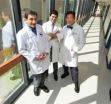(Press-News.org) AUGUSTA, Ga. – While it seems like restoring blood flow to an injured leg would be a good thing, it can actually cause additional damage that hinders recovery, researchers say.
Ischemia reperfusion injury affects nearly two million Americans annually with a wide variety of scenarios that temporarily impede blood flow – from traumatic limb injuries, to heart attacks, to donor organs, said Dr. Babak Baban, immunologist at the Medical College of Georgia and College of Dental Medicine at Georgia Regents University.
Restoring blood flow actually heightens inflammation and cell death rather than recovery for many of these patients.
"Think about trying to hold onto a nuclear power plant after you unplug the electricity and cannot pump water to cool it down," said Dr. Jack Yu, Chief of MCG's Section of Plastic and Reconstructive Surgery. "All kinds of bad things start happening."
Baban and Yu are collaborators on a study published in the journal PLOS ONE that shows one way stem cell therapy appears to intervene is with the help of an enzyme also used by a fetus to escape rejection by the mother's immune system.
Earlier studies indicate stem cells may improve recovery both by enabling new blood vessel growth and by turning down the now-severe inflammation, Baban said. The new study shows that indoleomine 2,3 dioxygenase, or IDO, widely known to dampen the immune response and create tolerance, plays an important role in regulating inflammation in that scenario. Stems cells and numerous other cell types are known to express IDO.
In fact, IDO boosted stem cell efficacy by about a third in their studies in animal models comparing the therapy in normal mice versus mice missing IDO. The researchers documented decreased expression of inflammatory markers, swelling and cell death, which correlate with a shorter, improved recovery.
That could be just what the doctor ordered for these patients, said Baban, the study's corresponding author. "We don't want to turn off the immune system, we want to turn it back to normal," he said.
Problems start with even a short period of inadequate blood and nutrients resulting in the rapid accumulation of destructive acidic metabolites, free radicals, and damage to cell structures, Yu said. Cell power plants, called mitochondria, which should be producing the energy source ATP, are among the early casualties, quickly becoming fat, leaky, and dysfunctional.
"The mitochondria are sick; they are very, very sick," Yu said. When blood flow is restored, it can put huge additional stress on sick powerhouses.
"They start to leak things that should not be outside the mitochondria," he said. Without adequate energy and with leaky powerhouses, cells quickly succumb. Inflammation, which is part of the normal healing process, escalates to help clean up the mess, but instead further exacerbates the problem.
While their findings were in limb injuries, the researchers say they should translate to the myriad of scenarios resulting in reperfusion injury. In fact, in just a short two hours in the operating room, Yu has seen free flaps, where tissue is moved from one area of the body to another to cover a burn or rebuild a breast, start dying from ischemia reperfusion injury.
"It cuts across many, many individual disease conditions," Yu said. Transplant centers already are experimenting with pulsing donor organs to avoid reperfusion trauma.
Next steps include seeing if more is better, by giving more stem cells – the researchers only gave one dose in the studies – as well as IDO-enhancing drugs, Baban said. This will include incubating stem cells with IDO, Baban said.
The researchers note that stem cell therapy isn't yet used to help patients' injured limbs recover, but is being studied clinically to aid stroke and heart attack recovery at MCG and other centers. Right now, the most physicians can do is restore blood flow and give broad-spectrum antibiotics.
"Sometimes it works, sometimes it doesn't," Yu said. "That is why this kind of pharmacologic intervention could be very, very important.
Endogenous stems cells enable the body to replace cells that are lost to wear and tear and aging. IDO is one of numerous immune modulators in the body. It remains unclear whether some individuals have higher IDO levels.
Dr. Mohamad Masoumy, a fourth-year general surgery resident at MCG and GR Health System, is first author on the PLOS ONE study.
INFORMATION:
Toni Baker
Communications Director
Medical College of Georgia
Georgia Regents University
706-721-4421 Office
706-825-6473 Cell
tbaker@gru.edu
Enzyme helps stem cells improve recovery from limb injuries
2014-05-14
ELSE PRESS RELEASES FROM THIS DATE:
By itself, abundant shale gas unlikely to alter climate projections
2014-05-14
DURHAM, N.C. -- While natural gas can reduce greenhouse emissions when it is substituted for higher-emission energy sources, abundant shale gas is not likely to substantially alter total emissions without policies targeted at greenhouse gas reduction, a pair of Duke researchers find.
If natural gas is abundant and less expensive, it will encourage greater natural gas consumption and less of fuels such as coal, renewables and nuclear power. The net effect on the climate will depend on whether the greenhouse emissions from natural gas -- including carbon dioxide and methane ...
New smart coating could make oil-spill cleanup faster and more efficient
2014-05-14
In the wake of recent off-shore oil spills, and with the growing popularity of "fracking" — in which water is used to release oil and gas from shale — there's a need for easy, quick ways to separate oil and water. Now, scientists have developed coatings that can do just that. Their report on the materials, which also could stop surfaces from getting foggy and dirty, appears in ACS Applied Materials & Interfaces.
J.P.S. Badyal and colleagues point out that oil-spill cleanup crews often use absorbents, like clays, straw and wool to sop up oil, but these materials aren't ...
Advance brings 'hyperbolic metamaterials' closer to reality
2014-05-14
WEST LAFAYETTE, Ind. - Researchers have taken a step toward practical applications for "hyperbolic metamaterials," ultra-thin crystalline films that could bring optical advances including powerful microscopes, quantum computers and high-performance solar cells.
New developments are reminiscent of advances that ushered in silicon chip technology, said Alexandra Boltasseva, a Purdue University associate professor of electrical and computer engineering.
Optical metamaterials harness clouds of electrons called surface plasmons to manipulate and control light. However, some ...
New efforts aim to shore up forensic science -- but will they work?
2014-05-14
Five years ago, a report on the state of forensic science by the National Academy of Sciences decried the lack of sound science in the analysis of evidence in criminal cases across the country. It spurred a flurry of outrage and promises, but no immediate action. Now, renewed efforts are underway, according to an article in Chemical & Engineering News, the weekly news magazine of the American Chemical Society.
C&EN editors Andrea Widener and Carmen Drahl note that the 2009 report served as a critical wake-up call to the public, defense attorneys and policymakers. Even ...
Building a longer-lasting, high-capacity electric car battery from sulfur -- video
2014-05-14
WASHINGTON, May 13, 2014 — A new prototype electric car battery could take you a lot farther and last a lot longer. Jeff Pyun, Ph.D., and his team at the University of Arizona are using modified sulfur, a common industrial waste product, to boost the charge capacity and extend the life of these batteries. Their work could also drastically reduce the price of electric car batteries, some of which currently cost more than $10,000 to replace. In the American Chemical Society's (ACS') newest Breakthrough Science video, Pyun and graduate student Jared Griebel explain the technology ...
Bioethics commission plays early role in BRAIN Initiative
2014-05-14
Washington, DC— Calling for the integration of ethics across the life of neuroscientific research endeavors, the Presidential Commission for the Study of Bioethical Issues (Bioethics Commission) released volume one of its two-part response to President Obama's request related to the Brain Research through Advancing Innovative Neurotechnologies (BRAIN) Initiative. The report, Gray Matters: Integrative Approaches for Neuroscience, Ethics, and Society, includes four recommendations for institutions and individuals engaged in neuroscience research including government agencies ...
Researchers ID changes that may occur in neural circuits due to cocaine addiction
2014-05-14
(NEW YORK – May 14) –– A research team from the Friedman Brain Institute of the Icahn School of Medicine at Mount Sinai published evidence showing that subtle changes of inhibitory signaling in the reward pathway can change how animals respond to drugs such as cocaine. This is the first study to demonstrate the critical links between the levels of the trafficking protein, the potassium channels' effect on neuronal activity and a mouse's response to cocaine. Results from the study are published in the peer-reviewed journal Neuron earlier this month.
The authors investigated ...
The International Meeting for Autism Research (IMFAR)
2014-05-14
ATLANTA, GA (May 14, 2014) -- The International Society for Autism Research (INSAR), a scientific and professional organization devoted to advancing knowledge about autism spectrum disorders, convened more than 1700 researchers, delegates, autism specialists and students from 40 countries for the 13th Annual International Meeting for Autism Research (IMFAR), the world's largest scientific gathering on autism research, from May 15 through May 17 at the Atlanta Marriott Marquis in Atlanta, GA.
Researchers and clinicians exchanged and disseminated the latest scientific ...
Turtle migration directly influenced by ocean drift experiences as hatchlings
2014-05-14
VIDEO:
The drift trajectories of virtual hatchling turtles from the breeding beaches to their juvenile development areas using the NEMO ocean model.
Click here for more information.
New research has found that adult sea-turtle migrations and their selection of feeding sites are directly influenced by their past experiences as little hatchlings adrift in ocean currents.
When they breed, adult sea turtles return to the beach where they were born. After breeding, adult sea turtles ...
Mobile phone data helps combat malaria
2014-05-14
An international study led by the University of Southampton and the National Vector-borne Diseases Control Programme (NVDCP) in Namibia has used mobile phone data to help combat malaria more effectively.
The study used anonymised mobile records to measure population movements within Namibia in Africa over the period of a year (2010-11). By combining this data with information about diagnosed cases of malaria, topography and climate, the researchers have been able to identify geographical 'hotspots' of the disease and design targeted plans for its elimination.
Geographer ...



